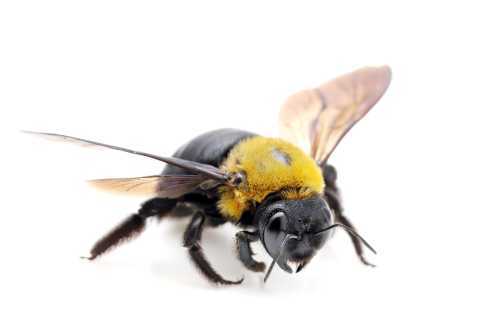Male vs Female Carpenter Bee
Telling the difference between a male vs female carpenter bee is sometimes a challenge, but there are certain characteristics and behaviors you can look out for.
Male vs Female Carpenter Bee
Most visitors to this website who ask questions, almost always refer to the behavior of the bee, and I believe this is because of the way this species interacts with humans.
These interactions provide key clues as to whether you are observing a carpenter bee male, or a female.
However, in some common species, there are physical characteristics that are quite easy to spot if you know what you are looking for.
1. Behavior: Male carpenter bees are territorial (but harmless)
Here are typical comments I receive relating to carpenter bees:
- This bee comes to visit me / wants to say hello / is friendly.
- This bee chases me or follows me around.
Every single email I have thus far received with such a comment, was describing the behavior of a male carpenter bee. If you are witnessing such behavior, you are looking at a male.
In fact, despite the humans tendency to anthropomorphize all kinds of creatures, including bees, such behavior from a male carpenter bee is actually investigatory and territorial, though quite harmless and very amusing to humans.
He cannot sting you, but if you were another male carpenter bee pitching for a mate on 'his' patch, he would chase you off! On the other hand, if he discovered a female was in the area, he would of course seek to mate.
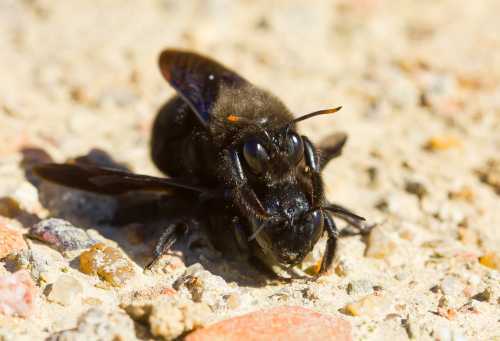 Violet carpenter bees (Xylocopa violacea) mating.
Violet carpenter bees (Xylocopa violacea) mating.2. Behavior: Female carpenter bees make the nests
If you witness a carpenter bee in the process of excavating a tunnel into soft wood, rotten wood or a tree trunk or dying branch, it will always be a female busy creating its nest. This is one of the easiest ways you can tell a female carpenter bee from a male.
Female carpenter bees are the ones that find the nest sites, and tunnel into the wood. On many occasions it's perfectly possible to get close and take photographs of this process, since despite being able to sting, carpenter bees are not aggressive if allowed to go about their business.
3. Physical characteristics
Spotting the difference between a male carpenter bee and a female based on physical characteristics, is more obvious for some species than others.
Here's what to look out for with two common species.
Xylocopa virginica: Male Eastern carpenter bee vs female
One of the most widely recognized carpenter bees in the USA and Canada, is the eastern carpenter bee, Xylocopa virginica, and telling the two apart is quite simple, as long as you get a good look at the face.
Females always have a black face.
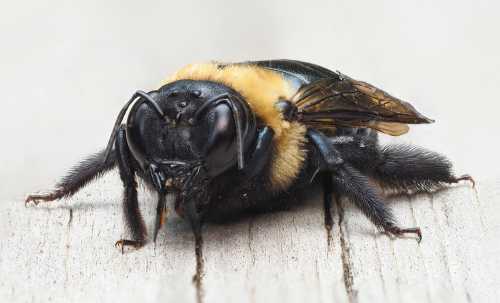 Female Eastern Carpenter Bee - Xylocopa virginica
Female Eastern Carpenter Bee - Xylocopa virginicaMale Eastern carpenter bees have a white face, and it's quite distinct.
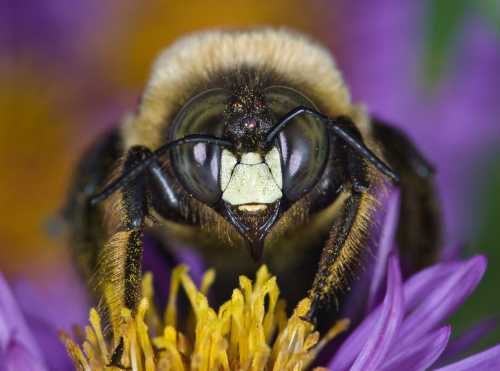 Male Eastern carpenter bee
Male Eastern carpenter beeXylocopa varipunctata: Female Valley carpenter bee vs male
In some carpenter bee species, the difference between the male and female is even more striking. They are a completely different color.
The females are black.
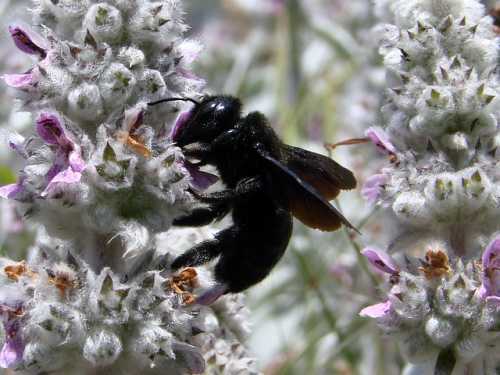 Female Xylocopa varipunctata -Valley carpenter bee
Female Xylocopa varipunctata -Valley carpenter beeThe male valley carpenter bees are golden-orange and have notably hairy legs and a green tinge to the eyes.
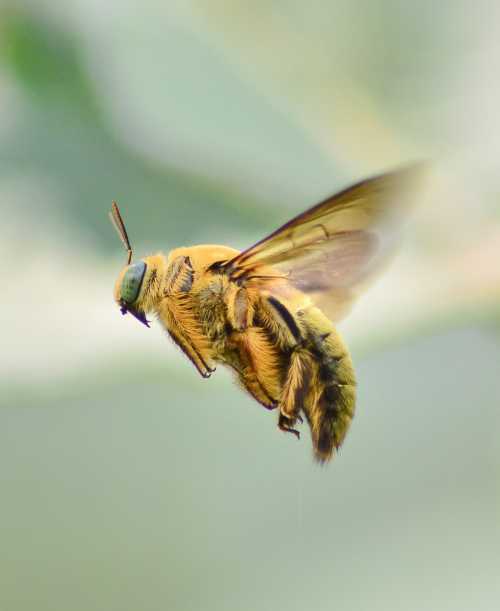 Male Xylocopa varipunctata -Valley carpenter bee
Male Xylocopa varipunctata -Valley carpenter beeAre male carpenter bees smaller than females?
I once read a comment which proposed that females are notably larger than males, and therefore, easy to tell apart if seen together, but is this always the case?
As far as I am aware, in some species it does appear that females are generally a little larger than males (according to studies, for example, concerned with Xylocopa valga1, and Xylocopa sinensis2). Whether or not the differences would be easy to discern whilst bees are active, I'm not sure.
For example, in the study concerning Xylocopa valga1 overall mean (average) body length of females was around 23mm, versus 20mm for males. Average (mean) wingspan for females was about 44mm, whereas for males it was approximately 40mm. These differences of a few millimeters may not easily be visible to the human eye, especially when bees are active or mid-flight.
In any event, a further study3 points out that there can be size and body mass variation even within species such as the eastern carpenter bee, Xylocopa virginica. Such variations can occur regionally and seasonally, as well as due to local environmental factors.
The study suggests that seasonal and sex differences in size are related to the different flight activity patterns of males and females in summer, and that geographic differences in size and mass may also be related to the length and duration of winters.
References:
1. He C, Zhu C (2020) Nesting and foraging behavior of Xylocopa valga in the Ejina Oasis, China. PLoS ONE 15(7): e0235769. https://doi.org/10.1371/journal.pone.0235769
2. Zhang YW, Zhao JM, Yang CF, Gituru WR. Behavioural differences between male and female carpenter bees in nectar robbing and its effect on reproductive success in Glechoma longituba (Lamiaceae). Plant Biol (Stuttg). 2011 Jan;13 Suppl 1:25-32. doi: 10.1111/j.1438-8677.2009.00279.x. PMID: 21134084.
3. Skandalis, Dimitri A., et al. “Body Size and Shape of the Large Carpenter Bee, Xylocopa Virginica (L.) (Hymenoptera: Apidae).” Journal of the Kansas Entomological Society, vol. 82, no. 1, 2009, pp. 30–42. JSTOR, http://www.jstor.org/stable/25568937. Accessed 18 May 2022.
If you found this page helpful or interesting, I'd really be grateful if you would share it with others - if not this page, perhaps another, such as Gardening For Bees.
Thank you so much :) .
